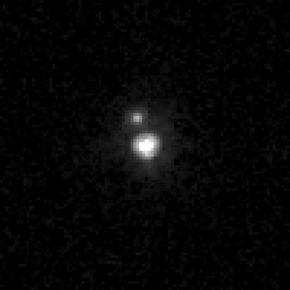
Back Vanth (satèl·lit) Catalan Vanth (měsíc) Czech Vanth (Mond) German Βανθ (δορυφόρος) Greek Vanth (satélite) Spanish Vanth (satelitea) Basque Vanth Finnish Vanth (lune) French Vanth Irish Vanth (lúa) Galician
 Vanth (top of Orcus) imaged by the Hubble Space Telescope in November 2005 | |
| Discovery[1] | |
|---|---|
| Discovered by |
|
| Discovery date | 13 November 2005 |
| Designations | |
Designation | (90482) Orcus I[3]: 350 |
| Pronunciation | /ˈvænθ/ |
| S/2005 (90482) 1[4] | |
| Adjectives | Vanthian |
| Orbital characteristics[5]: 67 | |
| Epoch 21.5 September 2006 (JD 2454000.0) | |
| 8999.8±9.1 km | |
| Eccentricity | 0.00091±0.00053 |
| 9.539154±0.000020 d | |
| Inclination | 105.03°±0.18° (to celestial equator) 90.54°±0.17° (to ecliptic)[a] |
| 53.49°±0.33° | |
| 274.51°[b] | |
| Satellite of | Orcus |
| Physical characteristics | |
Mean diameter | 442.5±10.2 km (occultation)[6]: 663 475±75 km (thermal)[7]: 1 [8]: 2 |
| Mass | (8.7±0.8)×1019 kg[8]: 4 |
Mean density | 1.9±0.3 g/cm3 (occultation)[c] 1.5+1.0 −0.5 g/cm3 (thermal)[8]: 4 |
| synchronous[9]: 6 [10] | |
| Albedo | 0.08±0.02[7] |
| Temperature | <44 K[6]: 663 |
Spectral type | moderately red[11]: 2702 V–I = 1.03±0.05[11]: 2702 |
| 21.8[12] | |
| 4.88±0.05[11]: 2702 | |
Vanth (formal designation (90482) Orcus I; provisional designation S/2005 (90482) 1) is a natural satellite or moon of the large trans-Neptunian dwarf planet 90482 Orcus. It was discovered by Michael Brown and Terry-Ann Suer using images taken by the Hubble Space Telescope on 13 November 2005. The moon has a diameter of 443 km (275 mi), making it about half the size of Orcus and the third-largest moon of a trans-Neptunian object. Vanth is massive enough that it shifts the barycenter of the Orcus–Vanth system outside of Orcus, forming a binary system in which the two bodies revolve around the barycenter, much like the Pluto–Charon system. It is hypothesized that both systems formed similarly, most likely by a giant impact early in the Solar System's history.[8] In contrast to Orcus, Vanth has a darker and slightly redder surface that apparently lacks exposed water ice, resembling primordial Kuiper belt objects.[11]: 2702
- ^ Cite error: The named reference
IAUC8812was invoked but never defined (see the help page). - ^ Cite error: The named reference
Suerwas invoked but never defined (see the help page). - ^ Cite error: The named reference
MPC69496was invoked but never defined (see the help page). - ^ Cite error: The named reference
jpldatawas invoked but never defined (see the help page). - ^ a b c Cite error: The named reference
Grundy2019was invoked but never defined (see the help page). - ^ a b Cite error: The named reference
Sickafoose2019was invoked but never defined (see the help page). - ^ a b Cite error: The named reference
Brown2018was invoked but never defined (see the help page). - ^ a b c d e Cite error: The named reference
Brown2023was invoked but never defined (see the help page). - ^ Cite error: The named reference
Ortiz2011was invoked but never defined (see the help page). - ^ Cite error: The named reference
Rabinowitz2014was invoked but never defined (see the help page). - ^ a b c d Cite error: The named reference
Brown2010was invoked but never defined (see the help page). - ^ Cite error: The named reference
Grundy-tnbswas invoked but never defined (see the help page).
Cite error: There are <ref group=lower-alpha> tags or {{efn}} templates on this page, but the references will not show without a {{reflist|group=lower-alpha}} template or {{notelist}} template (see the help page).